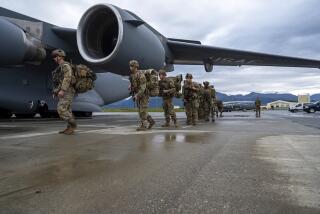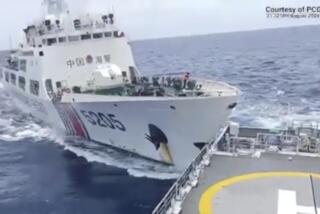U.S. Naval Ship Is First to Visit China Since ’89 : Asia: The American commander denies event is ‘political.’ But port call at submarine base is heavy with symbolism.
- Share via
QINGDAO, China — In an effort to rebuild U.S.-Chinese military ties and reduce tensions over a confrontation in international waters in October, a U.S. Navy cruiser sailed into this important northern naval base Wednesday on a friendly port call, the first by Americans since 1989.
Rear Adm. Bernard J. Smith, senior American officer aboard the modern Ticonderoga-class cruiser Bunker Hill, denied any connection between the visit and the October incident in which the aircraft carrier Kitty Hawk tracked a Chinese nuclear submarine in international waters off the Shandong peninsula.
The confrontation, which occurred on Oct. 27-29, began when the Kitty Hawk’s captain dispatched S-3 anti-submarine-warfare aircraft to track the sub. Chinese commanders scrambled jet fighters from land bases in response.
Chinese officials later warned through diplomatic channels that a recurrence would result in Chinese aircraft opening fire.
“This visit is in no way tied to past events,” Smith said here after a military band played the American and Chinese national anthems on a pier in Qingdao harbor. “There is nothing political about this visit. It is simply a visit of friendship.”
But the symbolism of the port call on the home base for China’s nuclear submarines could not be lost on the 400 American servicemen aboard the cruiser, nor the several hundred Chinese sailors standing at attention on the decks of their ships, nor the handful of American diplomats waiting ashore.
The United States remains the dominant naval power in the Pacific. But in an era of expanding military budgets here, China is in the process of developing a deep-sea navy, partly to defend its claims on the disputed Spratly Islands in the South China Sea.
The October confrontation occurred at an embarrassing time for both countries, just two weeks after U.S. Defense Secretary William J. Perry had visited Beijing to forge closer military relations.
Wednesday’s port call by the Bunker Hill was aimed at putting the military normalization process back on track.
“We have been slow in developing a relationship with the Chinese navy,” Smith said. “It’s been going on for approximately eight to nine years. It’s been on and off, driven--as all relationships are--by political occurrences throughout the world.”
U.S. diplomats who attended a dinner hosted in Qingdao’s military-owned Beihai Hotel by Rear Adm. Ding Yiping, chief of staff of the Chinese North Sea Fleet, said there was no mention of the Yellow Sea incident.
“This visit is all sweetness and light,” said one person who was present.
However, another diplomat said that one consequence of the incident is that the Chinese and Americans have opened serious discussions to create a military-to-military communication hot line aimed at defusing maritime encounters.
The last port call in China by an American warship, to Shanghai, was in May, 1989, and did not go well. It took place just as pro-democracy demonstrations were building in Beijing’s Tian An Men Square.
According to former U.S. Ambassador to China James R. Lilley, that port call was designed by the George Bush Administration to coincide with then-Soviet leader Mikhail S. Gorbachev’s visit to Beijing.
“I was told (in Washington) when first I went out to China, ‘This is the coup of the half-century--American-Chinese military ties right in the face of the Russians,’ ” said Lilley, who was just starting out as ambassador that spring, during a recent interview.
But the plan backfired as the naval visit was abruptly cut short after hundreds of thousands of people assembled in Tian An Men Square.
The day after the ships from the 7th Fleet departed Shanghai, the Chinese leadership declared martial law in Beijing.
Times staff writer Jim Mann in Washington contributed to this report.
More to Read
Sign up for Essential California
The most important California stories and recommendations in your inbox every morning.
You may occasionally receive promotional content from the Los Angeles Times.













